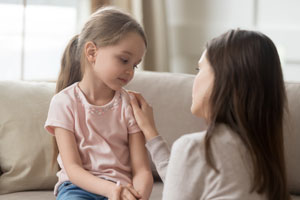Nina’s Story

It Only Takes One Harassment Incident to Impact a Childs Life
[ A True Story ]

Diane’s* only daughter was just seven years old when she first experienced hate speech.
Diane and her husband had spent the last five years raising their daughter Nina* and building their home in Los Angeles County. As a Turkish immigrant family in America, it was important that they instilled the values of respect, empathy, honesty, accountability, love, and open communication in their child—and very importantly, stayed true and proud of their Turkish heritage.
They enrolled Nina in Vista Grande Elementary School in Rancho Palos Verdes, and it seemed like their little girl was having a typical, healthy first grader experience. They had chosen the school in the district that seemed the best for their seven-year-old to make the transition from kindergarten and begin elementary school.
One day, Diane found her young daughter very upset when she got home from school. Nina then told her that an incident happened during class that day. Their first-grade class was having a lesson about world cultures and nations wherein the teacher had the students huddle together in a circle and each one shared about where their family was from. When it was Nina’s turn, she proudly said, “I’m from Turkey.” It shocked everyone when one of her classmates, a seven-year-old Armenian boy suddenly yelled at her in response: “I hate Turkish people!” Immediately, the teacher told him to be polite, but nothing more beyond that. There didn’t seem to be a firm reprimand or consequence that would clearly help the boy understand why what he did was not only disrespectful, but also why it was wrong on several levels. Beginning with the fact that it was an outright direct attack towards another person, and as a teacher of such young children, it’s her responsibility to understand and manage the emotional and mental effects of such an incident. Diane recalls what her daughter felt when the incident happened. “She told me, ‘I was so embarrassed, and I felt like all the other kids were watching me and kept talking about me.’ Nina felt so embarrassed. She did not want to go to school for a couple of days. She asked us why her classmate hated Turkish people.” Nina was so worried about an incident happening again, that this same boy or another would yell at her out of nowhere to tell her that they hated people like her and where she was from. Nina stayed in the classroom during recess for several weeks, isolating herself instead of playing with the other kids.
Diane and her husband worked hard to try to calm their young daughter, who was traumatized and afraid. They reached out to the school administration to report the incident, and expressed how they were very sad, angry, and concerned about it happening again to their daughter. The school authorities then sent a written apology to their family as well as to Nina. In addition to this letter, the school assigned a new language teacher whose husband was from Turkey the following week. This new teacher made a conscious effort to discuss Turkey and Turkish people with the class during a couple of lessons, purposefully acknowledging and involving Nina each time. Within this short period, everyone in the class learned about and became more familiar with Turkish culture, which made Nina more comfortable, welcomed, and happy once more. Diane shares that this effort helped their daughter recover from the incident and be more comfortable to engage with others in class again.
From this experience, Diane and her husband were able to see firsthand that race-related bullying and hate speech can happen anywhere and with any age—even somewhere as seemingly safe as a supervised first grade classroom. This experience also opened their eyes to the schools’ perpetual responsibility to protect students from harassment and violence and to maintain a non-discriminatory environment. One important takeaway from this experience that Diane shares is that beyond just merely increasing the chance of punishment, an effective anti-harassment program must incorporate strategies that will proactively prevent harassment. “While building a strong program often starts with developing and enforcing written policies and procedures, all of a school district’s programs and activities should support its anti-harassment efforts,” Diane explains. “The school’s instructional program, calendar of events, extracurricular activities, professional development efforts, and parent involvement initiatives are key to establishing an environment in which respect for diversity can flourish.”
The experience also helped deepen her insight on issues in society that are not merely small classroom incidents, but something larger. “Sometimes adults are silent on the issues of race, prejudice, and racial inequity because we ourselves are not comfortable talking about them. Sometimes we give no information or inaccurate information because we ourselves do not fully understand how racism works, why racial inequity still exists in our society so many years after the Civil Rights Movement, or what we can do about it. Remember, adults have also been socialized into society and are also breathing the smog of cultural racism on a daily basis. Although race and racism are difficult topics, it is important to educate ourselves and discuss them with children in an age-appropriate way.”
*Names were changed upon the subjects’ request for their privacy.
Do you have a story to share with us? Contact us using the form below and we will get in touch with you